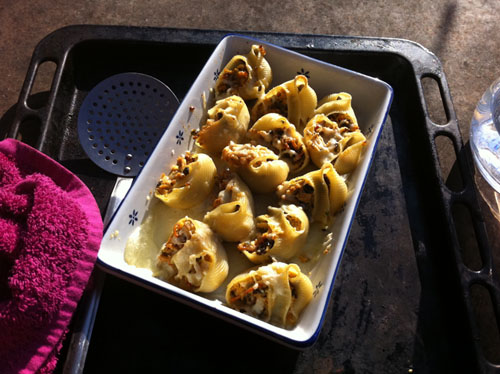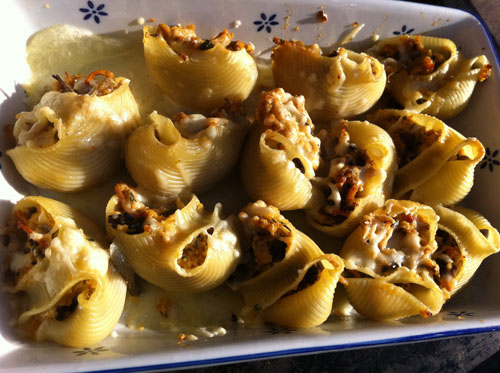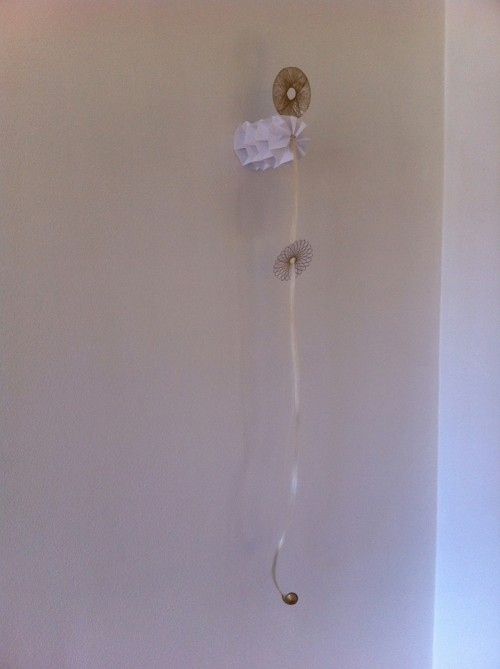Time flies! This week I managed to walk around Barcelona again and also Figueres, a town 15 minutes train from Camallera. I like the name of the town which means Fig Tree and this was the first place I visited with Clara on the day of my arrival for the screening of Ho Tzu Yen's Here.
And since Christmas was around the corner, the city was filled with Christmas decorations, and I took some photos of spiral-patterned street lights. I want to see them in the evening, but since the train comes every 2 hours and I don't really want to miss any before the sky turns dark, I could only view them unlighted. Maybe this week I will visit the town again, but in the evening.
And there's Dali Museum in Figueres, which I guess what the town is famous for among tourists.
What caught my attention most was the golden bread, and since I'm working with a lot of gold color, somehow this piece outshone the rest of his works. Not a fair comparison, but I do find this interesting as I've never studied or known that Dali does symbolism out of bread, significantly, golden bread.
As I stepped out of the museum then I realized that the buildings are 'guarded' by statues/sculptures with golden bread on their head.

And so, I googled it and from the-not-so-reliable-source-of-information-but-good-enough-as-initial-readings, I found:
BREAD
Is this by fear of missing some, Dalí represents it in his paintings and is also put to make surrealist objects with bread. In his paintings, the bread generally has, “hard and phallic aspect”, opposed to the “slackness” of the watches. Dalí was always a large admiror of the bread. He will paper Catalan round loafs, the walls of its museum of Figueras.
source: http://www.daliparis.com/english/dalinian-symbolics.html
Bread is a common subject throughout Dali's career; its meaning changes as Dali's interests changed. While in this work the bread is presented in an almost elemental way, suggesting that bread is the basic staple of life in Spain, it also serves as a sexual symbol in his surrealist work, and symbolizes the Eucharist in his later, "classic period" paintings. For a publicity stunt, Dali once had a loaf of bread baked for him that was four meters long!
source: www.1st-art-gallery.com/artists/dali/dal…
http://answers.yahoo.com/question/index?qid=1006021603856
When the liner reached New York, the press came out on
the pilot's boat, and Caresse Crosby, posing for the photographers,
urged the journalists to talk to Dali. They found him emplaced anew
amidst his paintings. Crosby gave the gentlemen of the press an
introduction to Surrealism, then whispered to Dali in French that the
ball was now in his court - whereupon the Dali show began with a
vengeance. During the crossing, he and Crosby had talked the captain of
the Champlain into having a fifteen-metre loaf baked for him when they
arrived in New York. Or, to be exact, a two-and-a-half metre loaf -
since the oven on board could not handle anything longer. Dali proposed
to distribute the bread to the waiting journalists as St. Francis had
scattered it to the birds. Things went differently, though. "It may
appear astonishing," he wrote in the Secret Life, "but it is a fact that
not one of the reporters asked me a single question about the loaf of
bread which I held conspicuously during the whole interview [...] On the
other hand, all these reporters were amazingly well informed as to who I
was. Not only this. They knew stupefying details about my life. They
immediately asked me if it was true that I had just painted a portrait
of my wife with a pair of fried chops balanced on her shoulder. I
answered yes, except that they were not fried, but raw. Why raw? they
immediately asked me. I told them that it was because my wife was raw
too. But why the chops together with your wife? I answered that I liked
my wife, and that I liked chops, and that I saw no reason why I should
not paint them together."
And after doing quite a number of clicking on google page, I came across this interesting ... article? Actually I'm not very sure what it is but is called The Futurists Cookbook
THE FUTURISTS COOKBOOK
http://www.tablematters.com/index.php/plate/cu/cufuture
In Barcelona, I would be staying at Clara's place, right in front of Santa Maria del Mar church, so I spent most of my time around the La Ribera area. I got lost a couple of time and ended up in this small plaza, or maybe too small to be called plaza. It is located in the intersection of Carrer Templers, Carrer De La Ciutat and Carrer Cervantes.
I noticed in that particular spot, for the countless time I got lost and found myself there, groups of men, or fathers would hang out with their babies or young kids. Many would bring their babies trolleys and dogs holding coffee or beer in one hand and cigarette on the other. I thought it was a coincidence at first, but as I came across the plaza again, the similar group of people were there. I asked Mariona and she told me that it was the site where many drug sellers would do their business at night. Pretty different than what I thought it would be.
Then because of what I had in mind as well for the past two weeks about the story of Keong Mas, I started to think about housewives and househusbands. The increasing trend of stay-at-home husbands and its social standing in contemporary lifestyle, etc.
I did some googling on this but I accidentally deleted the link. I have been trying to look into the implementation of househusband-trend in Spain also. Will look out more on this.
I will try to take pictures of the plaza with the people, but it's difficult to take photos of people. i am not sure what is the comfort zone of picture-taking here. Also I started to take notice of husbands or men who carry their babies alone on the street, and truly, there are many. An observation which I find really interesting.
And so, going back to the idea of food, Clara cooked oven-baked snail-shaped pasta filled with egg, hand-picked mushrooms and cheese, which tasted like heaven. I tried to cook snail-shaped pasta, in an attempt to make them gold (I pour a lot of olive oil and butter) but that didn't seem to work well. So I tried painting them gold and also the bread, petty much a direct mimicking of Dali's golden bread.





And continuing on the idea of food, I also bought snacks and one of them is a typical box biscuits that you can find almost anywhere.
It is also kind of food which I used to eat while I was young, back in Indonesia. We call it Mari Regal and it is snack that my dad in particular usually took, and he is still eating them now, in between heavy meals.
And somehow, that biscuits lead to these:
Some of the pieces are made out of .... muffin wrappers? I don't know what you call those paper cups that wrap your muffins.. haha.
I have always wanted to make works based on paper food utensils and plates, so I managed to get some muffins paper cups and also paper plates, which look more like simpler version of Victorian picture frames than plates.
The more white-colored ones were folded from square note papers which I bought from Chinese shops. Oh! And these shops are like Daiso! You can buy almost anything and they are relatively cheaper than any other places. Amazing.
Also the hair, which i had kept in mind. I managed to buy a huge knot of fake hairs in Barcelona.





That pretty much summarizes what I did in week 3.
I am not sure about the video anymore, it's been quite a challenge to do it. But will look at it further.
I have documented the drawings and ah, came out with a base story of the Keong Mas, on a larger context of this half-canon-half-fanon adaptation of an RPG-scenario which I'm working on, involving most of my characters-based projects. Check out the story here, but if you are unfamiliar with Konami's genso Suikoden, understanding the story might be a little difficult, cause I included quite a number of canon statistics in it. It is still not edited and most probably will be removing and adding information.
As for the snails, I'm still collecting them as when I need some fresh air. I notice there's been a lot more empty houses, i mean shells, as the weather grows colder.